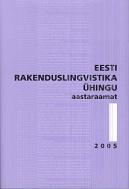Tellija kriteeriumid tõlke hindamisel ja nende sobivus koolitööde hindamissüsteemi alusena
Customer criteria of translation evaluation and their suitability in developing an evaluation system for student translations
Author(s): Arvi TavastSubject(s): Language and Literature Studies
Published by: Eesti Rakenduslingvistika Ühing (ERÜ)
Keywords: tõlkimine; tõlke hindamine; tõlketeooria; performatiivne lingvistika; tõlkekoolitus ; estonian linguistics ; Customer criteria of translation evaluation ; suitability ; developing an evaluation
Summary/Abstract: An increase in the volume of translations into Estonian has had two effects: emergence of linguistic quality assurance as a separate industry for checking the quality of commercial Estonian translations, and rapid development of translator training. This paper briefly describes translation evaluation criteria of the former, finds them to be unsuitable for the latter, and proposes a system of evaluation for student translations that facilitates the learning process. Translation customers develop their evaluation criteria with language-independence and objectiveness in mind. The resulting systems are quite different at first sight, but they share a number of common characteristics. Although the aim of translation training is to prepare the students for entering a marketplace with these exact requirements, it seems that copying these customer criteria would not be beneficial. The systems are too work-intensive for the instructor and, not being explicitly based on any modern translation theory, do not give the right kind of feedback to students. Evaluating translations presupposes a point of view on translation theories. This paper describes a model based on Fregean philosophy of language, classical terminology theory and Douglas Robinson’s performative linguistics. Presentation of the model is inspired by the ISO OSI model of computer network communications. Instead of source and target texts, the model works with participants of the exchange, their communicative intents and the speech acts they perform. The centre of the model is a human translator possessing full communicative competence and operating in the same way as the speaker and listener, as opposed to the text-coding mechanism described in many earlier translation theories. Based on this model, the paper presents an evaluation system for student translations that categorises errors according to their cause in the translation process, thereby providing students with constructive feedback with minimum effort from the instructor.
Journal: Eesti Rakenduslingvistika Ühingu aastaraamat
- Issue Year: 2005
- Issue No: 1
- Page Range: 139-153
- Page Count: 15
- Language: Estonian

